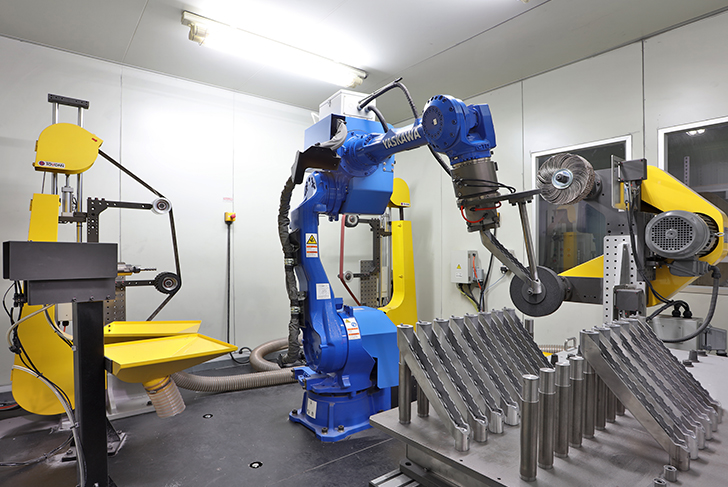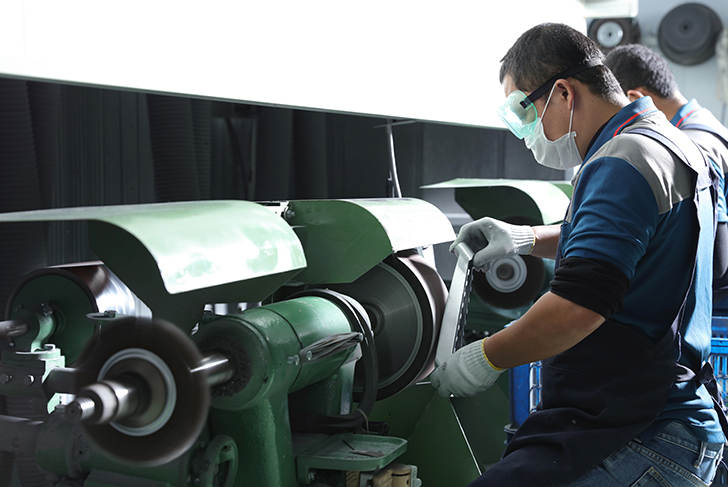- Home
- Deburring
-
Engineering Feedback on Product Designs

-
Die-Casting Tooling Development and Maintenance

-
Die Casting

-
Deburring

-
CNC Machining

-
100% Inspection for Airtight Testing

-
Surface Treatment

-
Quality Inspection

-
Assembly Services

-
Packaging and Transportation

-
Dedicated Production Line Services

Deburring
Chi-Tai's Grinding Process
- Chi-Tai's grinding process aims to handle the parting lines, gates, and casting overflows, and to modify the appearance of castings to achieve an optimal overall surface appearance.
Grinding equipment
- Chi-Tai has the grinding equipment on-site to manage this process. This ensures improved manufacturing scheduling, while also maintaining stable quality control, and also contributes to cost control.
- Chi-Tai currently operates two production lines - one for automatic grinding by using robotics, and the other for manual grinding that is handled by ten factory operators. These lines are designed to balance quality and production capacity to ensure stability during the production process.
1 Automatically Grinding
Yaskawa robotic arm grinding
A Yasakawa six-axis robotic arm, one of the world's top four industrial robots, has superior applications in semiconductor manufacturing and the automotive industry. Chi-Tai integrates this device with peripheral grinding equipment, including various sand belts, burr floating tools, force-controlled sand belt machines, force-controlled polishing machines, among others, to perform complex automatic grinding functions.
Robotic arms have superior spatial flexibility
When combined with complex offline programming software to generate complex paths, these high performance robotic arms overcome the common problem of having difficulties with automating grinding and polishing functions. Its front-end force-compliant tool or more advanced six-axis force sensor allows the arm to replicate human hand movements and accomplish genuinely accurate automated grinding and polishing for precision requirements, such as for straightness, flatness, curvature, concentricity, and thickness.
Robotic arm process stability
Stable quality during a twenty-four hour mass production operation is guaranteed to increase productivity, and also alleviate any problems caused by human errors.

2 Manual Grinding
- Grinding serves to eliminate the parting line and casting gates, while refining any defects in the casting to ensure a smooth surface.
- We use a grinding wheel machine to perform manual grinding.
- There is grinding equipment in our plant to self-manage the grinding manufacturing process and maintain quality control. This also allows us to improve production scheduling efficiency by providing greater control over the production process.
- Sample room: standard samples are evaluated in a sample room. This allows manufacturing procedures and samples to be examined visually on-site, ensuring the efficiency of mass production based on a master sample mold that initially passes inspection.

Grinding Process for Sustainable Operations
We offer both automatic and manual grinding to handle any form of casting. We prioritize stability, measurement efficiency, and flexibility in our approach by developing automated production in these two ways. We minimize dependence on operators and stabilize production capacity, which contributes to maintaining sustainable operations.
Our commitment to maintaining long-term stable operation is demonstrated through our investments in updated equipment. We believe that developing automated production is crucial to achieving this purpose. As a result, Chi-Tai is proud to be a stable and reliable supplier for all of your casting needs.
